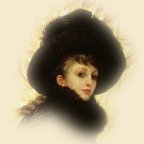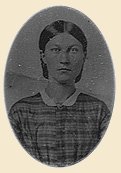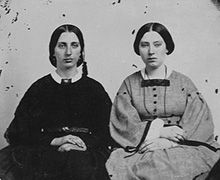



I often look at old photographs and wonder who the women in them were. What were their names? How old were they? What did they like to do? Were they wealthy or poor? Where did they live? While we may not be able to answer these questions, there is one thing we can glean from old photographs (besides imagining who they were). We are able to learn a lot about the clothing people wore during a certain time.
Photographs were invented in the late 1820s, and became widely available to the general populace in the 1840s. Photographs were a way for anyone to get their likeness reproduced, as it was less expensive than having one's portrait painted. Photographs were intensely popular in the 19th century (and have continued to be so, even after 150 years), and give us a link to what people looked like and wore generations ago.
There were several kinds of early photographs. The earliest being daguerreotypes (photographs on metal), and CDVs (Carte de Vistas), which came later. I own a couple of both, and it's interesting to see the differences between them. Both the CDVs (photographs printed on card) have more clarity, and one in particular is still so clear, it looks like its in the same condition it was in over 140 years ago when it was taken! The daguerreotypes, however, are both in bad condition. The one included in this article of the two young women is badly chipped and worn.
--Studying Fashion Using Old Photographs

If you are serious about studying what people wore in the past, investing in a handful of photographs is very worthwhile. You may find that just by looking at them (assuming they are all from the same period) you will begin to see the similarities and differences in styles of the period. For instance, the photos included with this article are all circa 1860 (give or take a few years). I dated them this way by looking for some characteristics of the styles popular at the time (narrow white collars, dropped shoulders, hairstyles, etc.), and deciding they were from around the 1860s. (Certainly before the onset of the bustle style, since none of them exhibit the early form of the bustle).
One thing I have learned from reading is that you can't take just one photograph and say that that is the end-all typical style of the period. Different women, of differing economic status, had different means and ways to keep up with the latest styles. Just like today, there are those that dress in the latest Paris couture fashions, and those that dress in a manner that harkens back to the 1980s classic look. You can't take one or the other and say that "this is always so". Rather, you must take time to study and compare and realize that the more prevalent an item (as long as all the photos aren't all from one religious sect, etc.) the more likely it was to have been a usual feature.
Let us take a look at the photos with this article to illustrate this point: In the photo of the two young women (fig. 2), the lady on the right has some sort of decorative buttons along the top of her pagoda sleeve. Looking at the other photos (and even still, others that can be found online and in books), this looks like an unusual embellishment to the dress. (No doubt used to emphasize the sloping of the shoulders) However, all of the women in the photographs have narrow white collars, meaning that it is more likely to have been the norm to do that. (This can be backed up by the research of others.) When you're researching clothing through photographs, to do extensive research, you have to gather a large number of photographs.

--Purchasing Antique Photographs
There are many places to purchase CDVs and tintypes for your collection, including local antique stores to online antique dealers to online auctions. You will find photos from many time periods, places, and prices. Before you start buying photos of a certain period, I would suggest educating yourself to familiarize yourself with the styles of the times. This way you can better date photos that may be undated. There are myriad books published on the subject of historical fashion. By taking the time to read and make familiar to yourself the differences between your chosen time period of interest and styles before and after, you will be enabled to make better buying decisions. Research, reading, and learning from the experts is the key to knowledge.
--Conclusion
Have fun when you're collecting and studying fashions from antique photographs. Remember, even if you find a photo that doesn't fit the time period you've chosen to study, but you just have to have it, buy it (if its in your price range, of course!). You never know, it may start you on another research adventure!
Artwork is October (1877) by James Tissot, courtesy of CGFA.
About
Additions
Articles
FAQ
Feature
Links
Poll
Reviews
Resources
Sewing
©2003 Across the Ages